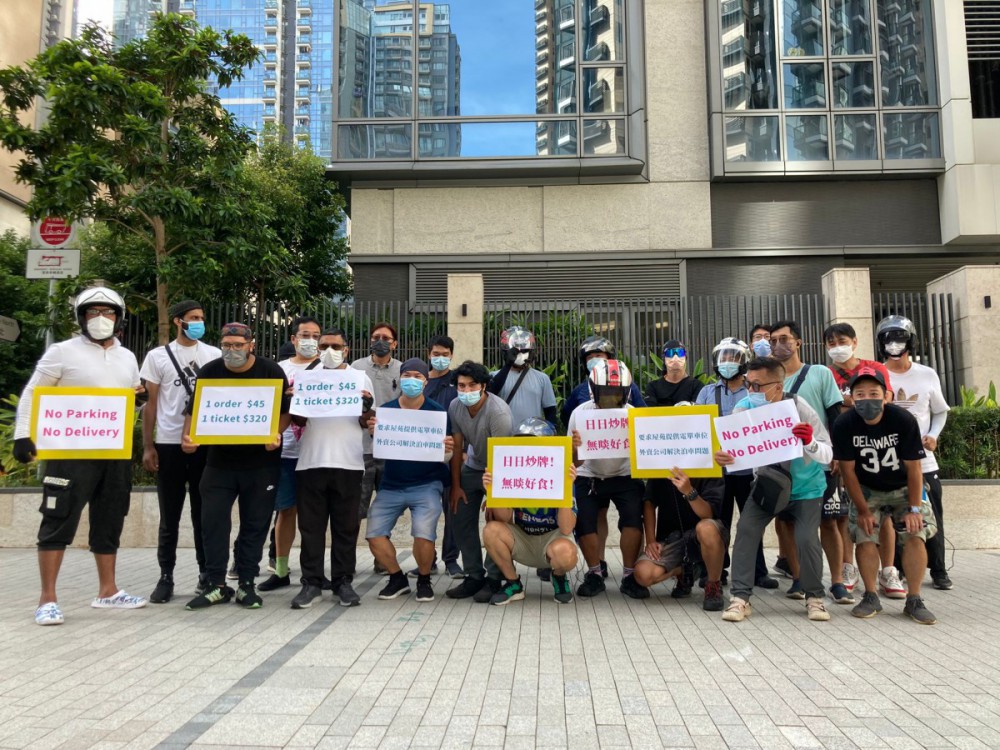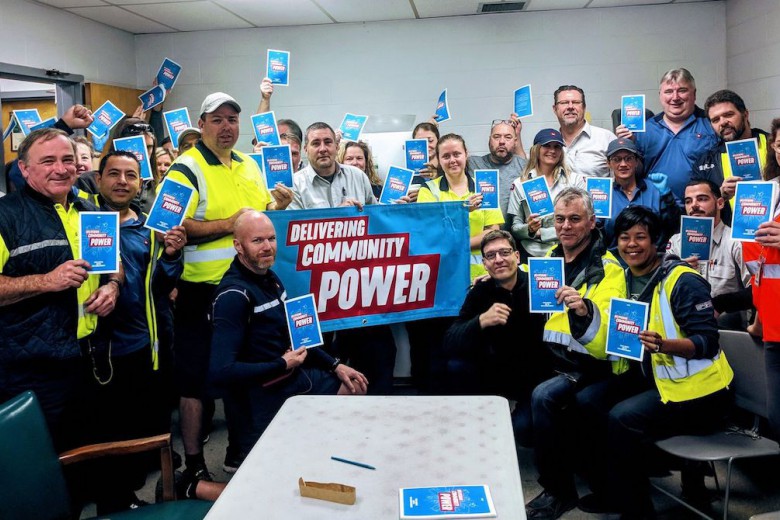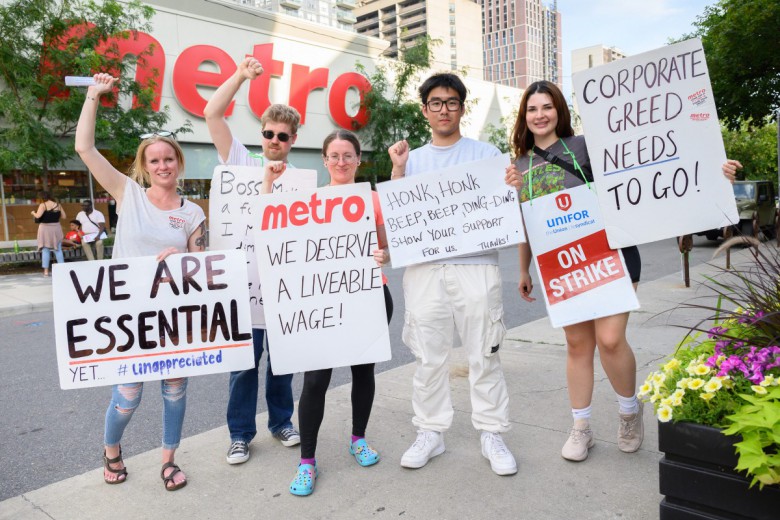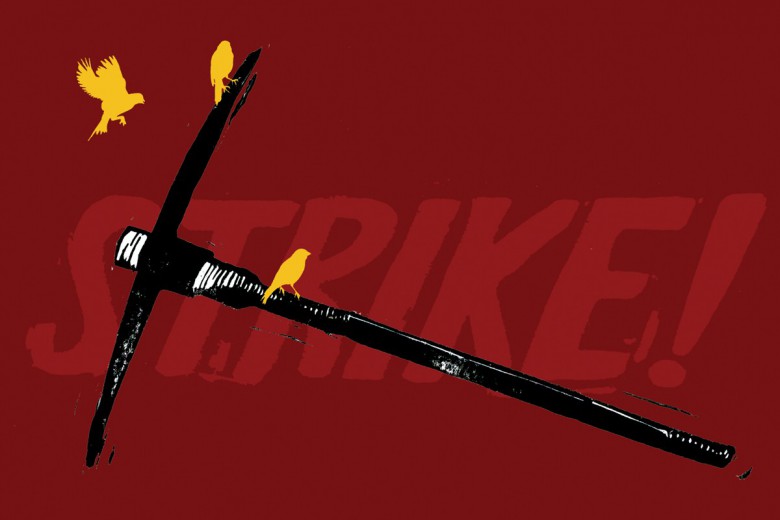At the pro-democracy march on New Year’s Day in 2020, 40 new unions took to the streets of Hong Kong. United behind a banner bearing the words “Unions Resisting Tyranny,” workers marched against China’s authoritarian rule.
The 2019–2020 protest movement exploded in the summer of 2019 when the Hong Kong government put forward a bill that would make it easier to extradite people to China from Hong Kong. Sensing that the bill would be a tool for the government to capture people who were outspoken against the Chinese Communist Party, Hong Kongers quickly mobilized against it, coordinating street protests and general strikes to incapacitate the city’s economy and pressure the government to concede to the demands of the movement. By October 2019, the Hong Kong government withdrew the bill.
Following their victory, the Anti-Extradition Bill movement continued to pick up steam. Many young workers formed unions to better coordinate strikes with other people in their industries. When the COVID-19 pandemic hit Hong Kong in January 2020, the Hong Kong government kept borders open with China, allowing the virus to spread into the city and threaten the lives of community members. In response, the Hospital Authority Employees Alliance (HAEA) – a new union consisting of medical workers – organized a five-day strike with astonishing speed to protest the lack of COVID prevention measures. By March 2020, hospital workers had forced the government to close all entryways from China into Hong Kong, stifling the spread of COVID in the city and protecting community members from the virus.
A new generation of workers was setting the agenda and proving that unions are political, militant, deeply embedded in social movements, and unafraid of taking direct action to force the state to meet their demands.
The hospital workers’ strike was the largest strike Hong Kong had seen in decades. For many workers, the HAEA strike and the new union actions of 2019–2020 represented the beginning of a new chapter for the city’s labour movement. After decades of suppression under British colonial and then Chinese rule, Hong Kong’s weak union movement was finally able to build power. A new generation of workers was setting the agenda and proving that unions are political, militant, deeply embedded in social movements, and unafraid of taking direct action to force the state to meet their demands.
On June 30, 2020, to suppress the Anti-Extradition Bill movement, the Chinese government implemented the National Security Law (NSL), threatening all dissenters – including pro-democracy politicians, student leaders, civil society organizations, progressive news outlets, organizers, and unions – with arrest and prison time.
Since the NSL was passed, the government has pressured unions into silence by publishing anti-union exposés on the front pages of state-owned media and repeatedly arresting labour movement leaders and trade unionists. Lee Cheuk-Yan, one of the founders and spokespeople of the Hong Kong Confederation of Trade Unions (HKCTU), has been arrested and sentenced to 14 months in prison. Two organizers, including HAEA chair Winnie Yu, are in custody, and three more are on bail. During the crackdown, 176 unions, including the HAEA and HKCTU, disbanded or had their union status revoked by the government.
Now living under the NSL and without the key union leaders who provided momentum, resources, and guidance during the Anti-Extradition Bill movement, organizers are reflecting on lessons they learned and how to keep building Hong Kong’s labour movement under China’s increasing political repression.
The labour movement post-NSL
“To compare our current era to our past, I always think of it in terms of Ultraman [hero] versus Megamonster [villain],” says Shing,* a veteran union organizer.
The “ultraman” Shing is referring to is the HKCTU, a union federation that provided technical support, campaign resources, and funding to unions for three decades. The “megamonster” he’s referring to are the unions that deal solely with employers and choose not to fight the state’s unjust policies. But ignoring labour justice is impossible in an undemocratic political system that prioritizes capitalists.
The unions that were formed in 2019, though short-lived, have shown Shing and other veteran organizers different strategies to engage workers in political issues, which can influence how they view and act on injustices in the workplace. “In the past, with these large pro-democracy unions and federations, it’s very clear who is Ultraman and who is the monster,” Shing notes. “But now, anyone can don the mask of Ultraman, and anyone can don the mask of Megamonster.”
In Hong Kong, we have never doubted that we will be back out on the streets in movement with each other. The question we must reflect on and answer is: how will we return?
He views the present as a period to critically reflect on whether the labour organizing was really all that effective in the past. “Some organizers and I had a sharing session in 2020,” Shing says, “and it was clear to us that our past work was inadequate, our vision for unions was narrow – we only cared about workers’ welfare. We couldn’t push union members to become more engaged with politics. Our traditional unions are a product of that.”
In Shing’s opinion, past organizers were over-reliant on the “firefighting” model – intervening in individual labour disputes and hoping that, by assisting with workers’ material benefits, workers would realize the need for systemic, political change and become active in the labour movement. While this method allowed organizers to build strong relationships with workers, workers rarely remained active in the union after the disputes were resolved.
Now that the HKCTU has disbanded, unions have less funding, a smaller network of allies, little sympathetic media, and less public engagement. Shing believes the time for “safe” tactics like the firefighting model is over.
Other tactics that the movement relied on, such as sustained, organized strikes, rallies and marches demanding changes to labour laws, and street booths educating the public about labour issues, are now also illegal. For the remaining unions, surviving means treading the line between fighting to better workers’ conditions and minimizing tactics of visible anti-government resistance, or they risk being disbanded.
Many new unions, such as the HAEA, have found it difficult to keep organizing under the NSL. Newer unions were more forthright in their support of the Anti-Extradition Bill movement and faced more government scrutiny, while older, more traditional unions that focus on bread-and-butter issues like wages and benefits have been more likely to be spared. Many new unions shut down.
For the remaining unions, surviving means treading the line between fighting to better workers’ conditions and minimizing tactics of visible anti-government resistance, or they risk being disbanded.
The few remaining unions are not giving up. For example, staffer Simon* says that the Hong Kong Hotel Employees’ Union (HKHEU), a union that was at the forefront of the new union movement, has since scaled back its organizing and is instead focusing on recreational activities like networking events for members, hikes, and beach cleanups. The activities are for fun, but also to connect members and build and maintain the recognition, trust, and unity that strengthen the community.
The Hong Kong Theatre Arts Practitioners Union (HKTAPU) is also continuing to fight for workers’ rights. In July 2022, a large video screen collapsed on a backup dancer during boyband Mirror’s concert, critically injuring and immobilizing the dancer. In response, HKTAPU called for an investigation into the companies responsible for setting up the stage and ensuring its safety. They also demanded that the injury be treated as an industrial accident and that dancers be viewed not just as performers but as workers who deserve protection. The union’s fight and continued media coverage of the accident prompted the Hong Kong government to contact the union and ask about the employment conditions of backup dancers. This was the first time a pro-democracy, independent union was given space to have a constructive discussion with the government since the NSL.
Since the NSL was passed, the government has pressured unions into silence by publishing anti-union exposés on the front pages of state-owned media and repeatedly arresting labour movement leaders and trade unionists.
But many union members aren’t supportive of the labour movement’s pivot back toward bread-and-butter issues. In an interview with Initium on the eve of their disbandment, HAEA executive members shared that their membership had plummeted since 2020. The NSL had forced the HAEA to put its political agenda on the back burner and focus exclusively on workplace health and safety or be disbanded.
Bobby,* an organizer with the HKTAPU, thinks the lack of trust has to do with the initial expectations unions communicated to their members. “Many new unions told their members they would be focused on wider social justice issues,” he says. “That’s why when the social movement cooled down, these unions didn’t know what other issues there were to discuss with their members. In contrast, our union had planned to engage in bread-and-butter issues in addition to supporting the social movement from the get-go. And so we still have a lot of members coming to us for support.”
HKTAPU initially formed as part of the Anti-Extradition Bill movement. Since the NSL, the union has pivoted to push for better contracts for its members, a fight HKTAPU executive committee member Vivian* thinks is still worthwhile. To her, an arts practitioners’ union is especially vital in this era because the NSL impacts creative freedom and artists feel pressured to produce work that appeals to pro-Beijing politics in order to retain funding from the government. “I think we shouldn’t disband,” she says. “We still have a lot of things to say as a union.”
The new normal
However, many workers do not share Vivian’s opinion that they need unions to fight for their rights. In 2021, a strike organized by non-unionized delivery workers prompted conversations between organizers about whether unions were still critical in the post-NSL labour movement, with media calling it the “post-union era.”
In November 2021, hundreds of delivery workers working for online delivery platform foodpanda – many of whom are South Asian – went on a two-day strike for higher wages, a fairer way of calculating delivery distance, a system to reduce waiting time at restaurants, and an end to the punitive measures the company uses to control riders, like forced breaks and forced ends to their shifts. The strike ground to a halt foodpanda’s grocery shopping service, pandamart.
foodpanda delivery workers on strike in November 2021. Photo courtesy of the Riders’ Rights Concern Group.
“People call this the post-union era because this strike, which happens to be a decentralized, non-unionized strike, occurred right after the NSL labour crackdowns in 2021,” Mak Tak Ching, a staff member at the Riders’ Rights Concern Group, shares. But he disagrees with this framing. “This strike was decentralized because gig work itself has a fragmented nature,” Mak clarifies. “Organizers did not immediately come up with these new strategies and tactics ourselves. Unions might still play a role in organizing in the future.”
When foodpanda further decreased workers’ wages despite agreeing to change delivery distance calculations in 2022, workers struck again. This time, over a thousand workers participated.
In 2022, they replicated their strike tactics from 2021, hoping for success. However, this time, foodpanda was prepared to retaliate. The company divided workers by raising wages for some and docking pay for others. Management created incentives for part-time workers to work during the strike and refused to negotiate with striking workers. Workers were effectively shut down. Since then, organizers’ morale has been at an all-time low.
Though the foodpanda strike didn’t make the gains workers had hoped for, there is one strike tactic Mak thinks is worth exploring further. While on strike, Han Chinese couriers went home and watched TV. Mak says that although they’re not gathered together at a rally, this was still a strike.
“A lot of people will disagree [with this tactic],” he laughs. “They think that struggle is about rallies and press conferences, and being on the streets. But it’s not the only way: go home and tangping [lie down and resist the hustle and the grind], fuck up your boss. I think many people logically understand why this works, but they haven’t let go of the memories of past struggles.”
The comeback era
Writing for International Viewpoint, student activist Zi-yuet argues that although new unions have been forced to stop organizing around larger political issues and focus on livelihood issues under the NSL, unions remain political vehicles and tools to push for change. The HAEA strike in 2020 showed many workers in Hong Kong that unequal labour relations are caused not only by economic factors, but also by the government’s “stewardship of Hong Kong’s neoliberal crony-capitalist system,” as Zi-yuet writes. This includes the outdated labour laws that fail to protect gig workers’ rights, the overriding power of the Arts Development Council to withdraw funding for political productions, and government negligence in investigating companies that prioritize profit over the safety of workers. There is still a need to draw attention to these unjust working conditions. It’s important that workers leverage their power, whether through unions, grassroots organizations, or other creative means.
In April 2023, two former HKCTU staff members – Joe Wong Nai-yuen and Denny To Chun-ho – applied for a permit to host a May Day march. After multiple formal meetings with the authorities throughout the month, Wong was detained without reason by police, during which he withdrew the application for the march. Afterward, he broke down.
Both Wong and To anticipated this outcome, and while organizing, they also agreed that a march of a few hundred participants would not create any concrete changes in society. They still decided to organize because, as they write in Lausan, “The social movement is a long and arduous road, and we cannot simply focus on the successes and failures of one particular moment.” Their application for the May Day march demonstrates the pressure activists face organizing under the NSL as well as their resolve to keep testing waters.
Resistance demands constant transformation: to step out of our comfort zones, to work with new people, to organize outside of traditional union frameworks. It requires us to be water.
Is there revolutionary potential in any of the union activities happening right now? “We don’t know that,” Shing answers. “What we do know is that unions, in remaining as a platform for justice and cross-movement building, may still bring changes to our society. Even those who may not be ‘useful’ now, we shouldn’t be giving up on them.”
Leo Tang, an HKCTU organizer who had been arrested multiples times for his involvement in the labour movement, wrote in Lausan that “we must resist the tendency to ask the same old questions – often informed by our political and ideological predispositions – as this may only constrict our thinking.” Resistance demands constant transformation: to step out of our comfort zones, to work with new people, to organize outside of traditional union frameworks. It requires us to be water.
In Hong Kong, we have never doubted that we will be back out on the streets in movement with each other. But we have been preoccupied for too long with the question: when will we be back? Now, the question we must reflect on and answer is: how will we return?
*Shing, Bobby, Simon, and Vivian chose to use pseudonyms to protect their identities.







